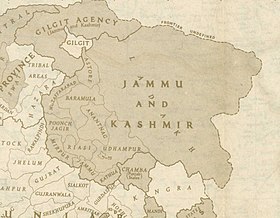Pahari (Poonchi)
| پونچھی, پہاڑی Punchhī, Pahāṛī | |
 | |
| Native to | Pakistan |
|---|---|
| Region | Poonch Division of Azad Kashmir Poonch District of Jammu and Kashmir |
Native speakers | 1,000,000 500,000 |
| |
| Language codes | |
| ISO 639-3 | – |
Pahari (پونچھی, also known as "Poonchi") is an language variety specifically spoken in Poonch Division of Pakistan-admistered Azad Kashmir and in Poonch District of Indian-administered Jammu and Kashmir.[1] This Poonchi Pahari dialect has been seen either as a separate dialect from the one known as known as Pothwari.[2][3] The term "pahari" or "pahadi" originates from the word "pahad", denotes "mountain" or "hill", and collectively describes the inhabitants of mountainous areas.



Pahari speakers, focusing on language choices during social interactions and the pattern of language shift in the Poonchi dialect of Pahari. It also aims to find out the linguistic preferences and shifts within the Pahari-speaking community. Using a stratified random sampling technique, data were collected from 300 respondents through a structured questionnaire. The questionnaire, designed in a multiple-choice format, facilitated the collection of relevant information from the informants. The major findings reveal a notable trend towards the adoption and promotion of Urdu and English among Pahari speakers, influenced by the increasing exposure to Urdu in academic and social settings and the global prominence of English. The linguistic landscape in Rawalakot, district Poonch reflects a pattern of multilingualism, where individuals possess varying levels of proficiency in Pahari, Urdu, and English. The fourth generation shows a pronounced shift towards bilingualism in Urdu and English, signaling a diminishing proficiency in Pahari. The study suggests a trajectory of language shift from Pahari towards Urdu and English, driven by socio-economic factors and changing societal norms.[4]
references
[edit]This article has not been added to any content categories. Please help out by adding categories to it so that it can be listed with similar articles. (November 2024) |
- ^ "30.", Each and Her, University of Arizona Press, p. 30, 2022-05-03, doi:10.2307/j.ctv2jhjw5h.31, retrieved 2024-11-11
- ^ Abbasi 2010, p. 104.
- ^ Grierson 1919, p. 505 and corresponding map.
- ^ Kashmiri, Naveed Sarwar Shad; Rashid, Haroon Ur (2023-09-30). "Language Dynamics among Pahari Speakers: Trends in Language Use and Shift over Time". Pakistan Languages and Humanities Review. 7 (3): 996–1013. doi:10.47205/plhr.2023(7-III)86 (inactive 2024-11-13). ISSN 2708-6461.
{{cite journal}}: CS1 maint: DOI inactive as of November 2024 (link)
